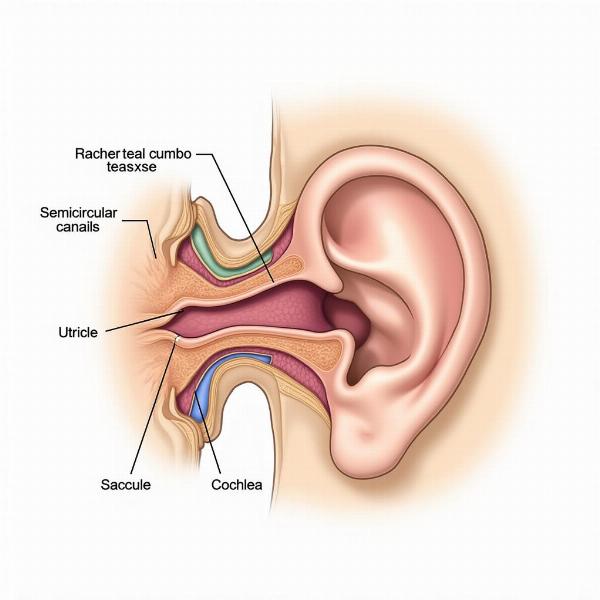Vestibular meaning in Hindi often revolves around the concept of प्रकोष्ठ (prakoṣṭha), which translates to “cavity” or “chamber”. Understanding the vestibular system, its functions, and related terminology can be challenging. This guide provides a detailed exploration of “vestibular meaning in Hindi,” encompassing its various interpretations, related vocabulary, and common misconceptions.
Understanding the Vestibular System and its Hindi Equivalent
The vestibular system, crucial for balance and spatial orientation, resides in the inner ear. Its Hindi equivalent, often incorporating प्रकोष्ठ (prakoṣṭha), highlights the system’s location within the bony labyrinth. While a direct, single-word translation might not exist, the meaning is conveyed through descriptive phrases like “आंतरिक कान का संतुलन तंत्र” (āntarik kān kā santulan tantra – inner ear’s balance system). This emphasizes the system’s role in maintaining equilibrium.
 Vestibular System Diagram
Vestibular System Diagram
The vestibular system detects head movements and position, sending signals to the brain to coordinate balance and eye movements. This complex process allows us to maintain stability while walking, running, or even simply standing still.
Vestibular Disorders and Terminology in Hindi
Various disorders can affect the vestibular system, causing dizziness, vertigo, and imbalance. Understanding the Hindi terminology associated with these conditions is essential for effective communication and treatment. Common terms include चक्कर आना (chakkar ānā – dizziness), सिर चकराना (sir chakrānā – vertigo), and असंतुलन (asantulan – imbalance).
Understanding these terms can help individuals experiencing vestibular issues accurately describe their symptoms to healthcare professionals, especially in Hindi-speaking regions.
Why is Knowing “Vestibular Meaning in Hindi” Important?
Knowing the Hindi terminology related to the vestibular system is particularly important for:
- Patients: Accurately conveying symptoms to doctors.
- Medical Professionals: Communicating effectively with Hindi-speaking patients.
- Translators/Interpreters: Providing accurate translations of medical documents.
- Researchers: Conducting studies in Hindi-speaking populations.
Vestibular Rehabilitation Therapy (VRT) and its Hindi Explanation
Vestibular Rehabilitation Therapy (VRT) helps individuals regain balance and reduce dizziness. Explaining VRT in Hindi involves conveying the concept of retraining the brain to compensate for vestibular dysfunction. This can be described as “वेस्टिबुलर पुनर्वास चिकित्सा” (vestibular punarvāsa cikitsā – vestibular rehabilitation therapy).
What does Vestibular Hypofunction mean in Hindi?
Vestibular hypofunction, a condition where the vestibular system doesn’t function properly, can be explained in Hindi as “कमजोर वेस्टिबुलर कार्य” (kamzor vestibular kārya – weak vestibular function).
Conclusion
Understanding “vestibular meaning in Hindi” is crucial for effective communication and treatment of vestibular disorders within Hindi-speaking communities. This comprehensive guide has explored the various aspects of the vestibular system, related terminology, and the importance of accurate translation in a medical context. This knowledge empowers individuals to seek appropriate care and fosters better communication between patients and healthcare providers.
FAQ
- What is the simplest Hindi word for vestibular? While a direct equivalent is challenging, प्रकोष्ठ (prakoṣṭha) relating to the inner ear cavity is often used in descriptive phrases.
- How do I describe vestibular neuritis in Hindi? You can describe it as “वेस्टिबुलर न्यूरिटिस” (vestibular nyūritis).
- What is BPPV called in Hindi? While a direct translation isn’t commonly used, describing the symptoms as “स्थितिजन्य चक्कर” (sthitijanya chakkar – positional dizziness) can be helpful.
- Where can I find more information about vestibular disorders in Hindi? Consult with a medical professional or search online for Hindi resources related to ear, nose, and throat (ENT) conditions.
- Is vestibular rehabilitation therapy available in India? Yes, VRT is available in many hospitals and clinics across India.
- How can I find a vestibular therapist who speaks Hindi? Consult with your doctor or search online for vestibular therapists in your area, specifying your language preference.
- What are some common symptoms of vestibular disorders in Hindi? Common symptoms include चक्कर आना (chakkar ānā – dizziness), सिर चकराना (sir chakrānā – vertigo), and असंतुलन (asantulan – imbalance).
Meaning-Hindi.in is your one-stop solution for all your Hindi translation needs. We offer a wide range of professional translation services, including business and commercial document translation, certified and legal document translation, technical and user manual translation, website and localization services, educational and academic document translation, and fast and urgent translation services. Our expertise in various specialized fields ensures accurate and culturally sensitive translations. Contact us today for a free quote! Email: [email protected], Phone: +91 11-4502-7584. Meaning-Hindi.in is committed to bridging the language gap and facilitating clear communication.